Benjamin Bouchouari (165cm/5’5”, 65kg/143lbs) is the latest player Ligue 2 Saint-Étienne have recruited to boost their hopes of immediate promotion back to Ligue 1 for next season. The 20-year-old Belgium-born Morocco youth international joins Les Verts for a reported €1.1m fee, making his signing Saint-Étienne’s most expensive of the summer, at the time of writing.
Bouchouari came through the youth ranks at Anderlecht, Genk and KV Mechelen in Belgium before moving to the Netherlands when he joined Willem II’s academy in 2017. He later moved to Fortuna Sittard and then Roda JC.
At Roda, the young midfielder made his first strides into senior football as he broke into their first team in 2020/21. Last term, he was a regular starter in the Eerste Divisie — the Dutch second tier — with just six players enjoying more league minutes than Bouchouari, who turns 21 in November.
So, who is Bouchouari as a player and what can Saint-Étienne supporters expect to see from their latest signing — who’s been described by ASSE boss Laurent Batlles as: “a small midfielder with a lot of technical quality. He can become important for us. He has to adapt to the French Ligue 2 but he is interesting” — once he hits the pitch in France’s second tier?
This Benjamin Bouchouari tactical analysis and scout report aims to provide Saint-Étienne fans with some in-depth insight on their new man to answer the above questions, as well as provide some ideas on how Bouchouari may best fit into his team’s tactics, based on analysis of his 2021/22 campaign with Roda in the Dutch Eerste Divisie.
Data analysis
We’ll kick off our analysis of Bouchouari with a look at the 20-year-old’s data profile, as seen in figure 1 below. We’ll first explain a couple of the more ambiguous metrics labelled in this graph. We must stress that these weren’t created as a result of some intense fine tuning or a highly intelligent process, just a basic combination of some raw metrics to create a potentially helpful metric for use in this analysis, in this writer’s view.
‘Possession involvement’ is a combination of passes per 90 and passes received per 90, which we combined to try and get a measure of, as the name indicates, how involved, overall, the player is in his team’s possession phases in relation to other players in the data set labelled in figure 1.
‘Positive passing’ is a combination of forward passes per 90, progressive passes (A forward pass that attempts to advance a team significantly closer to the opponent’s goal) per 90 and passes to the final third per 90. These were combined as a means of looking into how aggressive/forward-thinking the central midfielder is with the ball in relation to his peers, particularly designed to highlight his effectiveness in the ball progression phase of play.
‘Penetrative passing’ is a combination of through passes per 90, passes to the penalty area per 90 and smart passes per 90, designed to look at the player’s defensive line-breaking nature, particularly with a view to looking at the player’s effectiveness in chance creation.
‘Creative passing’, then, is a combination of xA per 90, shot assists per 90 and key passes per 90. This one is designed to show how effective the player is at directly creating goalscoring opportunities for his teammates.
We appreciate the labelling here could be clearer but hope that with these explanations, the metrics make sense and it’s clear why we’ve put these particular bits of raw data together to create what we feel is a slightly more interesting measurement.
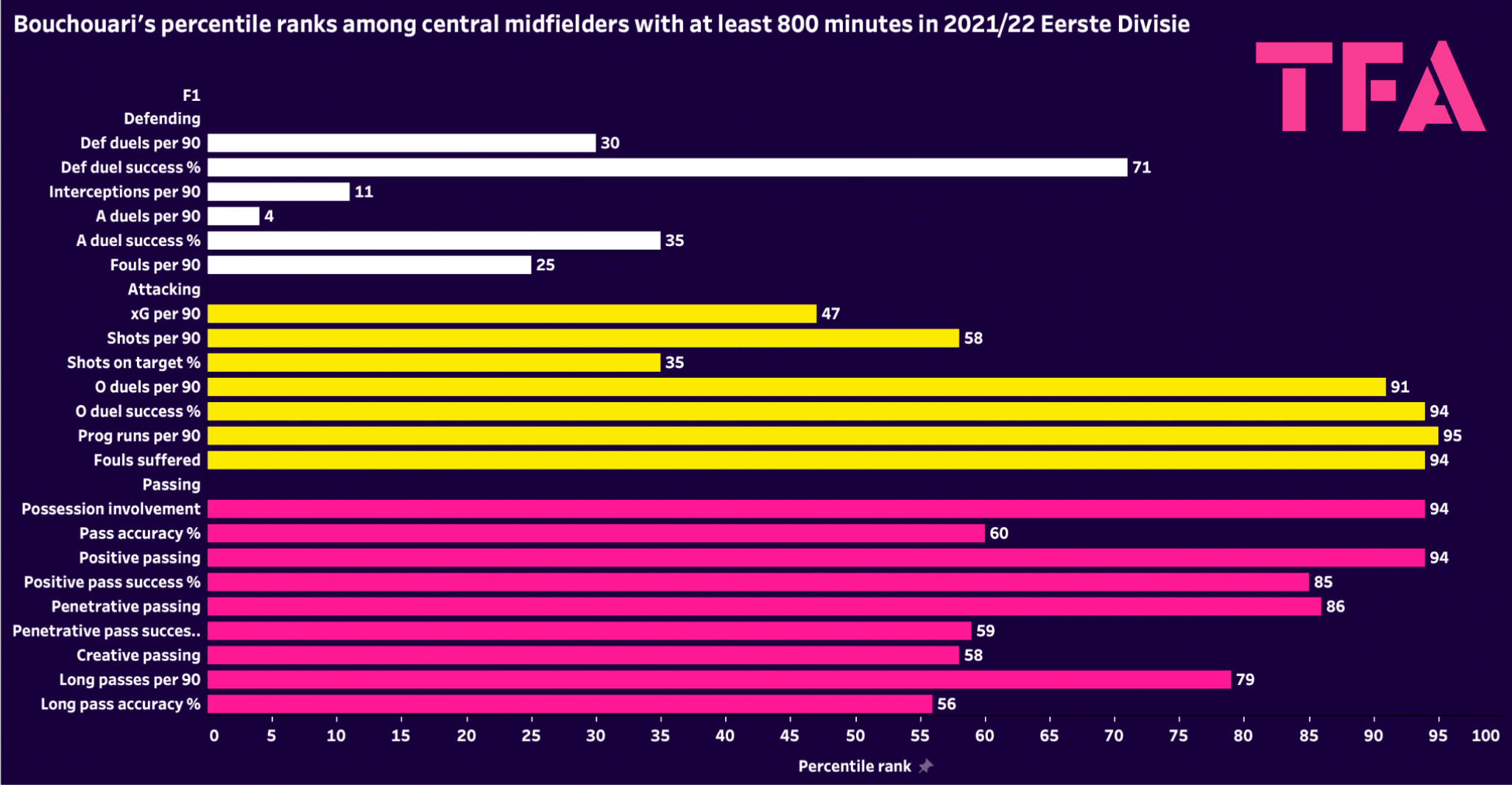
Bouchouari isn’t a standout in terms of his defensive contribution at all, though his defensive duel success rate isn’t too shabby. Additionally, don’t expect to see him popping up with tonnes of goals or attempts at goal, as this isn’t exactly his forte either, at present.
It’s clear from figure 1, and with the aforementioned metrics in mind, that Bouchouari’s strengths lie in ball progression, which is surely what Saint-Étienne will be looking for him to do at Stade Geoffroy-Guichard.
His percentile ranks in possession involvement, positive passing, offensive duels, progressive runs and fouls suffered, when compared with Eerste Divisie central midfielders to have played at least 800 minutes in 2021/22, suggest as much.
Bouchouari doesn’t solely rely on his passing or ball carrying to influence the game in the progression phase, but rather he likes to use a lot of both skills, often carrying the ball forward with dribbles and, also, often driving the ball forward into more advantageously positioned teammates via his progressive passing ability.
It’s clear that in relation to other Eerste Divisie central midfielders last term, Bouchouari also gave a good account of himself in the chance creation phase, as his 86th percentile rank in penetrative passing suggests.
However, it’s clear that his primary role at Roda was in ball progression as opposed to chance creation.
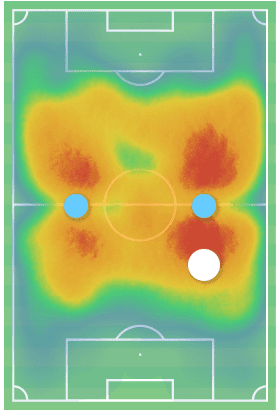
The player’s 2021/22 heatmap in figure 2 also visualises a lot about him in terms of which areas it’s common to see him occupying. Bouchouari is something of a ‘shuttler’ in that his strengths lie in operating between the two boxes and facilitating the ball’s movement from one end of the pitch to the other.
It’s common to see him dropping deep into space to receive from the backline, for instance, taking the ball on the half-turn and carrying/driving it forward into the final third for a teammate to set up a goalscoring opportunity for his side. This is a role that gets the best out of Bouchouari’s strengths in possession, which we’ll go on to analyse in the next section. We’d also imagine he’ll continue playing in this way at Saint-Étienne.
Possession involvement
The first metric that we’d like to explore in a little bit more detail with this scout report is Bouchouari’s performance in possession involvement. Indeed, it’s clear that his team likes to get the ball to him a lot, which won’t come as a surprise given his role at Roda and his qualities in ball progression.
However, it takes more than just effort from his teammates to get the ball to him regularly — it also takes plenty of effort and skill from Bouchouari himself to ensure this happens. The Moroccan midfielder is an active scanner and great at moving into space while evading cover shadows to make himself not just a passing option for his teammates, but a good passing option for his teammates.
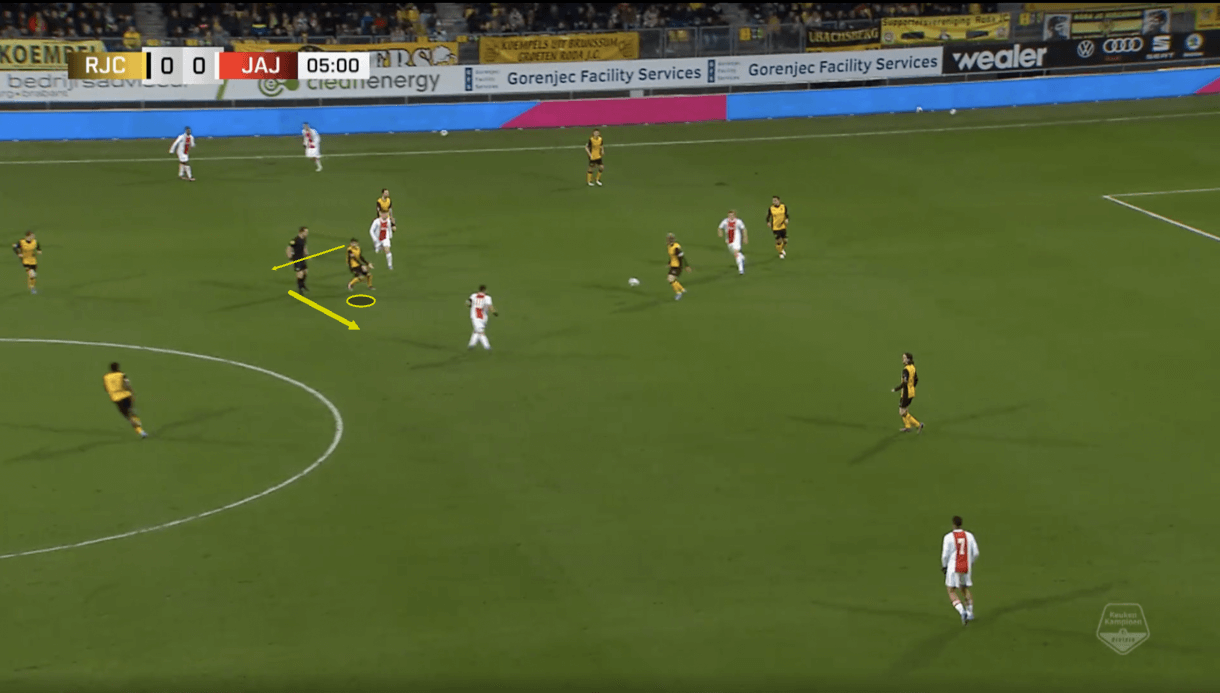
Take figures 3-5, for example. Here, Roda were in the process of building out from the back, with Bouchouari positioned slightly ahead of the ball carrier at this moment. The midfielder can be seen scanning over his right shoulder to survey the situation upfield while moving away from the opposition player to his left, aiming to exploit some space between and behind two opposition midfielders.
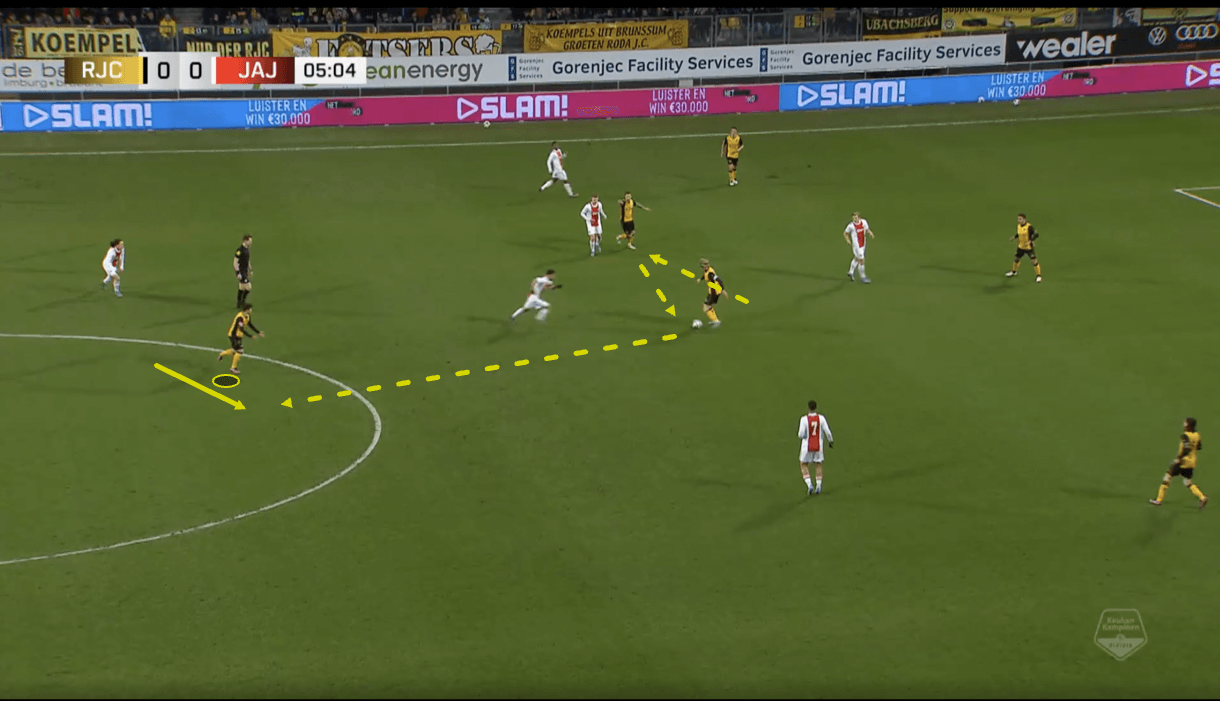
Bouchouari’s teammate didn’t take the option of passing to him in figure 3, instead linking up with a deeper player beside him which drew the opposition’s press higher, as figure 4 shows. This, in turn, created an opportunity for Bouchouari to pull away from the opposition midfielders into the space opening up behind them.
Still, the 20-year-old had to be aware of his surroundings to ensure if he did receive the ball now, he’d 1. Have a good picture of the pitch in his mind to help his decision-making and 2. Ensure that if he did receive the ball, he wouldn’t turn straight into a defender and turn the ball over.
Additionally, Bouchouari had to remain active with his off-the-ball movement to remain a good passing option for the ball carrier — out of the pressing opponents’ cover shadows. We see all of this in action in figure 4, demonstrating Bouchouari’s solid spatial awareness and deliberate intelligent movement to keep himself free as a passing option.
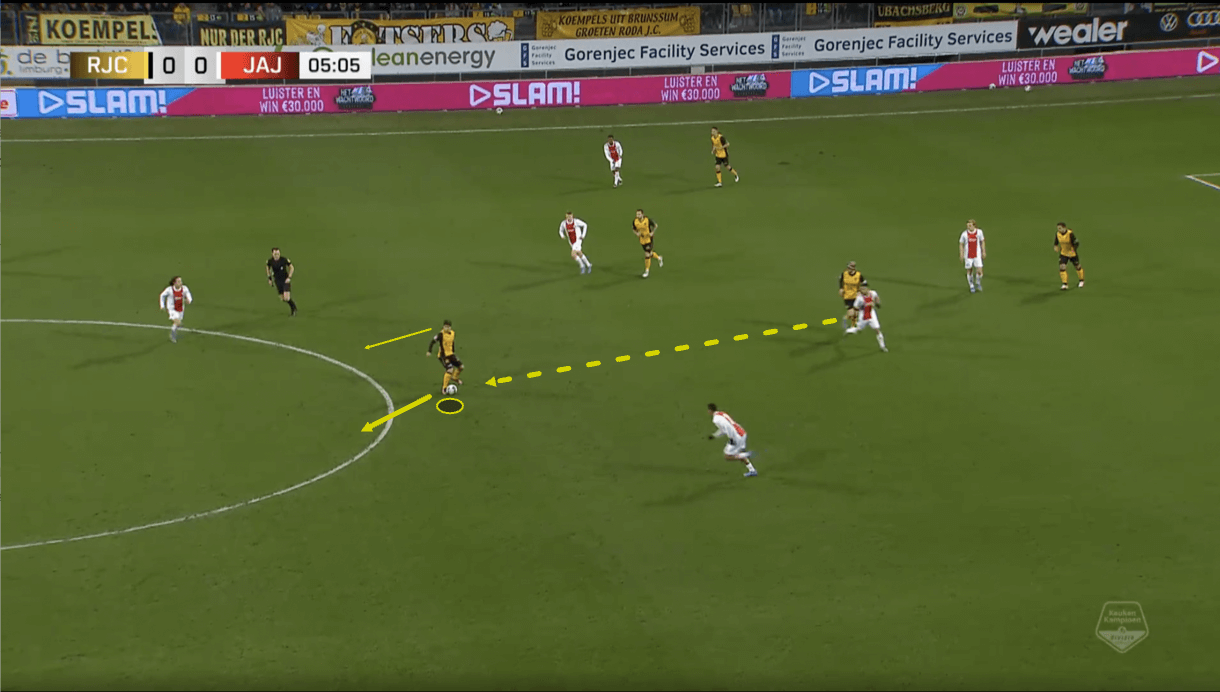
Thanks to the spatial awareness and movement Bouchouari had displayed, he then received the ball in figure 5, taking it on the half-turn to quickly start facing the opposition’s goal and driving forward.
So, yes, the player’s role and on-the-ball ability obviously influence his possession involvement. His teammates wouldn’t want to pass to him if he weren’t as good as he is on the ball. However, he needs to help them achieve this too via his positioning and movement, which is a key area of his game as displayed in this particular example.
All of this combines to make Bouchouari heavily involved in his team’s possession play, particularly in the middle third of the pitch where the 20-year-old will typically roam between the deeper and more advanced areas as a ball progressor.
Progressive passing
Next up, we’ll take a look at Bouchouari’s progressive passing ability, which shines in the data profile we analysed previously as the 94th percentile rank for ‘positive passing’ shows.
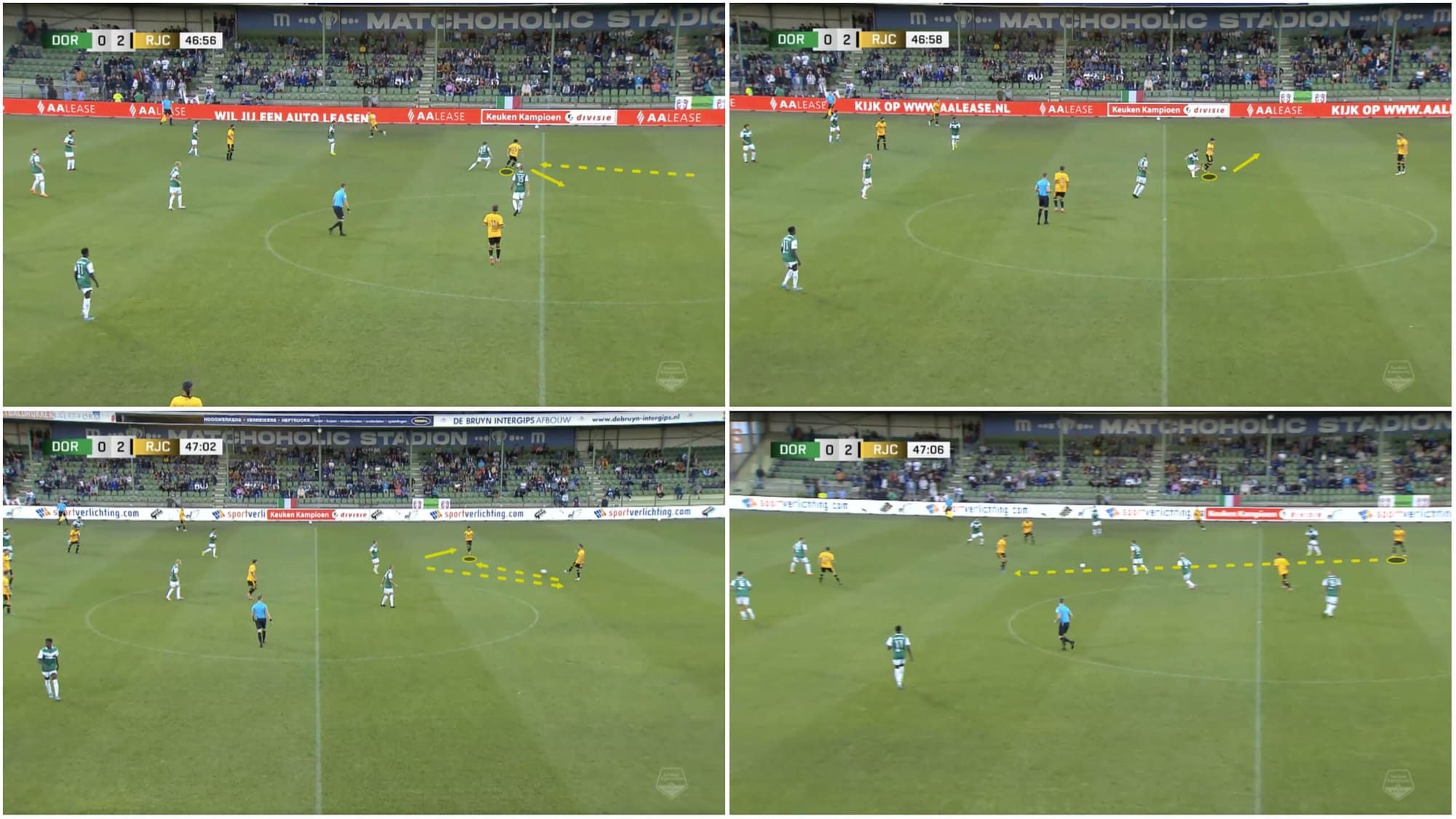
Figure 6 demonstrates several key elements of Bouchouari’s ball progression ability in one passage of play. From this image, we catch a glimpse of Bouchouari’s press resistance, ability to find space, ability to turn and face the opposition’s goal and, of course, technical passing ability.
In the top two quadrants, we see Bouchouari’s press resistance in full effect. Just before this image, he received the ball with his back to goal in the middle third of the pitch.
Not one to panic under pressure, Bouchouari took the ball in his stride and began zig-zagging in and out a couple of times to shake off the defender on his back. As he escapes back to the outside in the top right quadrant, we see the opposition defender tracking him in the process of slipping over while Bouchouari can escape the situation just fine.
These two quadrants demonstrate the midfielder’s cool nature when under pressure with his back to goal, technical dribbling quality on the ball, agility and balance. These are all helpful traits for the midfielder to possess when it comes to receiving from the backline before being tasked with turning and getting his team in a much better position.
After evading the pressure, Bouchouari quickly linked up with the nearest centre-back while dropping into space where he can then receive the ball back again — this time, facing the opposition’s goal.
From here, the midfielder demonstrated amazing vision to split the opposition’s midfield with a low-driven ball into the feet of a teammate dropping into the right half-space at this moment. From there, that player can turn and drive into the final third or link up with a teammate before moving into the final third, showing how effectively Bouchouari played the role of the ball progressor between the thirds at Roda the last term.
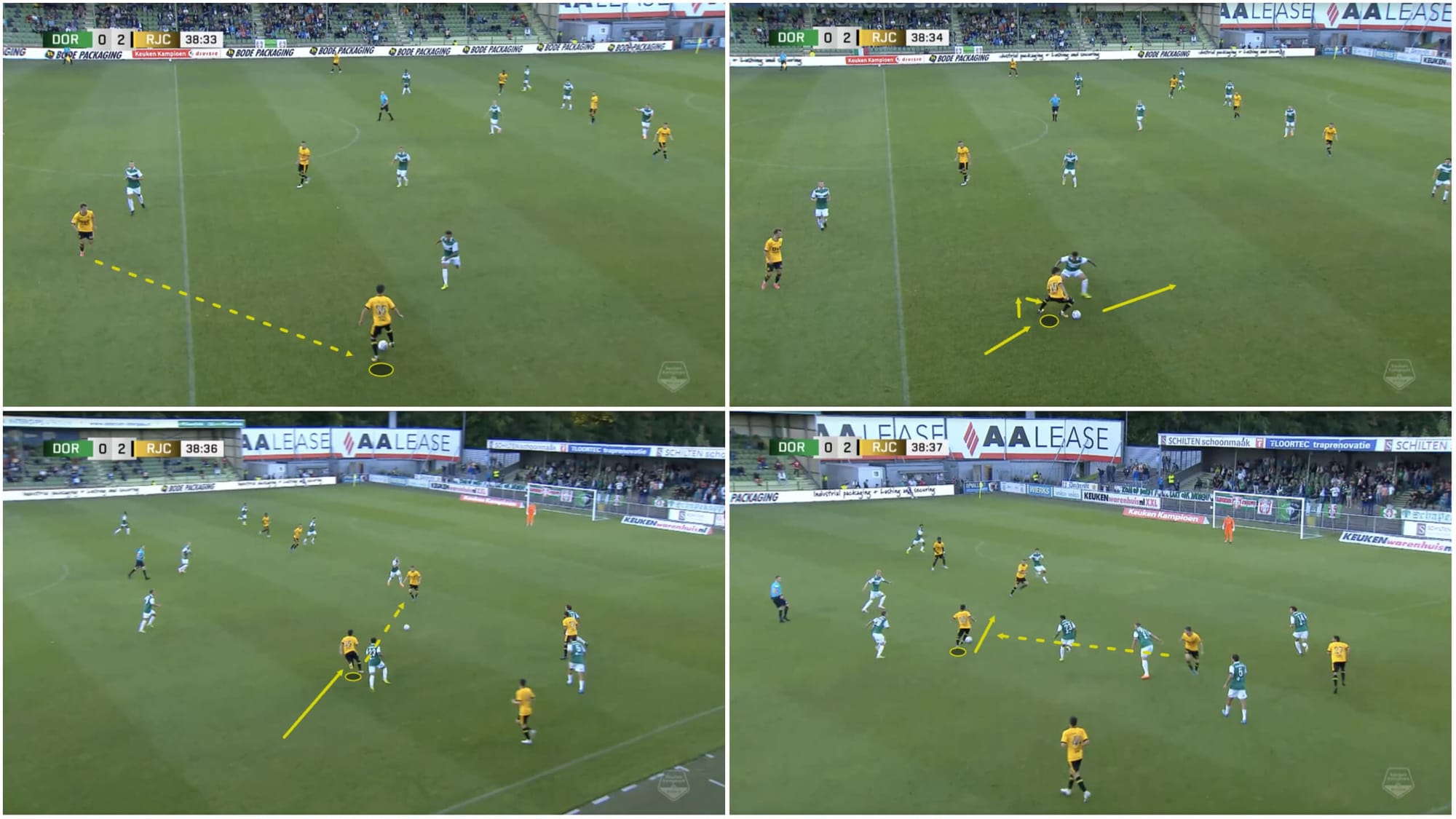
Watching Bouchouari play is like watching the embodiment of ‘pass and move’; this is clearly an idea that’s been ingrained into the midfielder’s psyche. This is another skill that the 20-year-old frequently uses to progress his team through the thirds, with an example of this shown in figure 7.
After receiving the ball deep on the right in the top left quadrant, Bouchouari quickly turns and takes the pressing opposition player on.
After showcasing some quick feet to beet the pressing player (as seen in the top right quadrant), we see the Roda man pass the ball to the feet of a player occupying an opposition centre-back in the forward line.
After playing this pass, Bouchouari doesn’t just stop and call it a job well done, he keeps going to try and offer the receiver a one-two option. This is a very common sight in the Moroccan’s game which can help his side to overload the opposition, as he’ll already have beaten at least one man, if not more, with his initial carry before playing the bass and bypassing the defenders to link up with the receiver, as we see in the image above.
In this case, the receiver plays the ball back to Bouchouari, taking up the one-two option that the midfielder’s intelligent movement provided. This helps Bouchouari to create an overload versus the opposition’s backline with his subsequent dribble into the final third, giving him the opportunity to play a defence-splitting pass or continue carrying the ball himself.
Many of Bouchouari’s penetrative and creative passes (as defined when discussing the data visual in figure 1) come as a result of plays like this. The reason he plays a relatively high number of penetrative passes despite generally starting quite deep and operating as a shuttler between the thirds is partly due to the frequency at which he makes these one-twos to progress upfield and get into dangerous creative passing positions, as we see in figure 7, so this is a major, natural part of his game that we’d expect to see continue at ASSE.
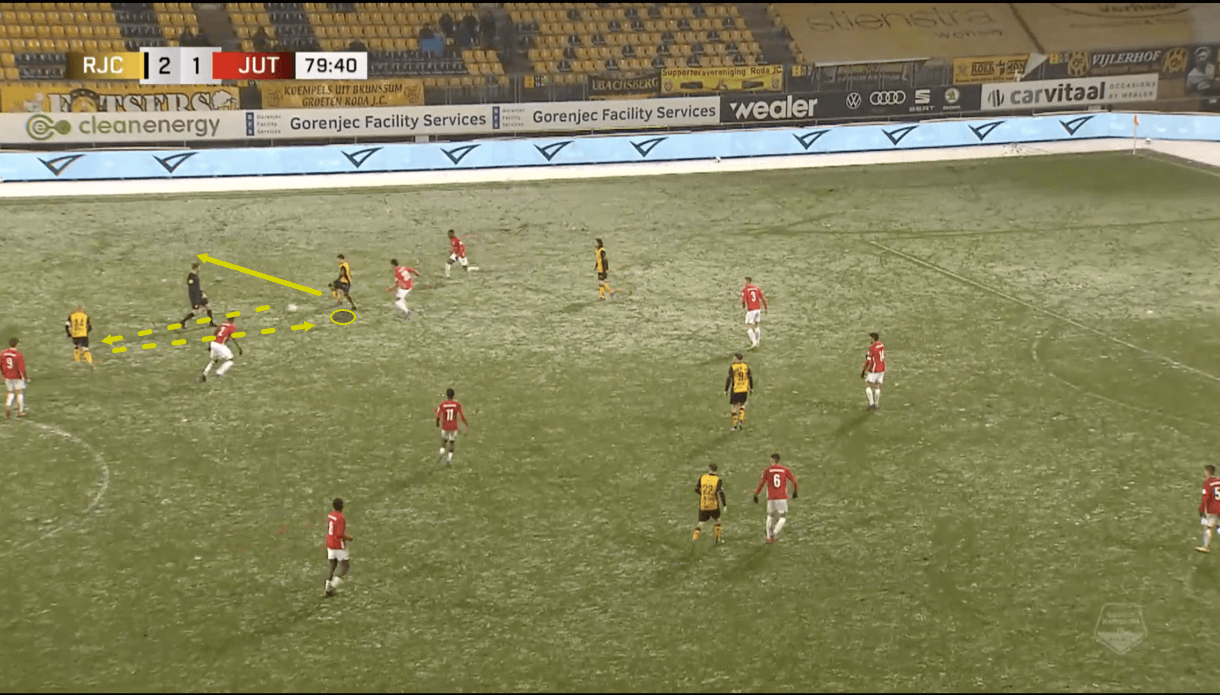
While Bouchouari is a forward-thinking progressive midfielder, he’s very tactically intelligent and great at understanding space. As a result, it’d be fair to say he doesn’t rush things too often or try to unnecessarily force the issue when it comes to receiving and turning to go forward or trying to pass the ball through a brick wall, so to speak.
If the opportunity to go forward is simply not on, which is what Bouchouari deemed to be the case in figure 8, he’s comfortable and intelligent enough to take a step back in order to move forward. As a result, when the midfielder received the ball here in figure 8, he did immediately send it back as pressure mounted on him from behind, before moving out to the space on the left.
After moving out into the space on the left, the midfielder had the ball returned to him — this time with more space around him to progress the team.
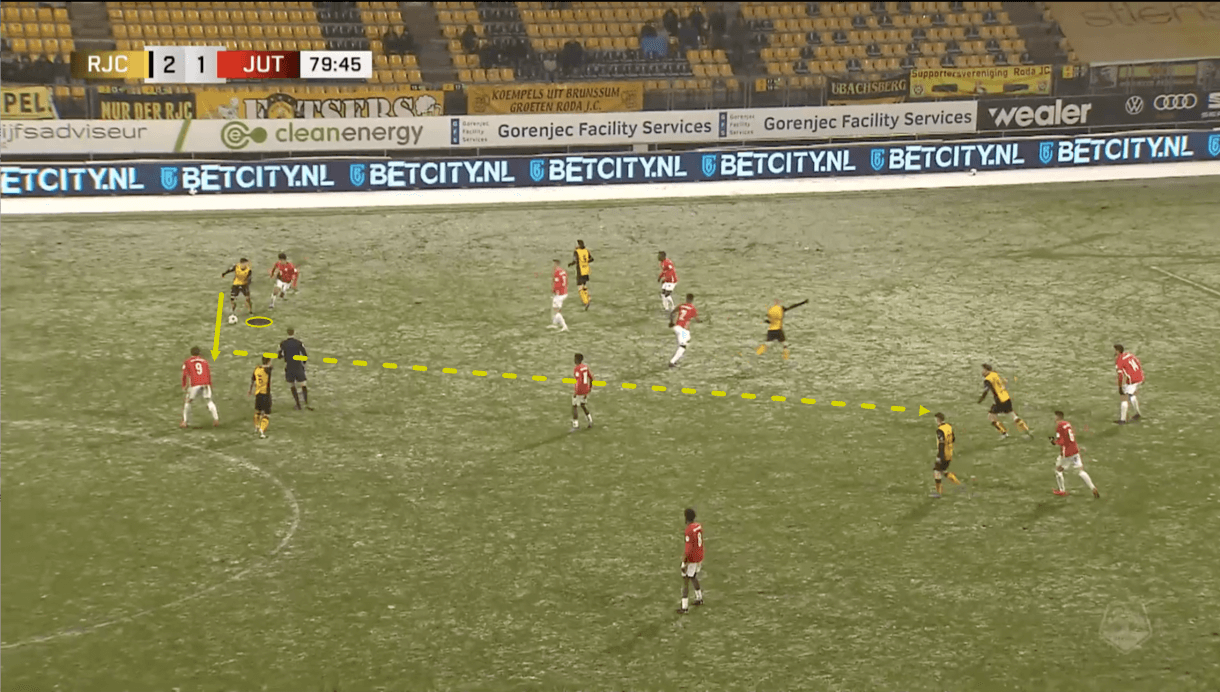
This time, as we see in figure 9, he was able to receive the ball at a far better angle to progress the play than had been the case in figure 8.
After carrying the ball infield a little bit, while getting his head up and scanning his surroundings to assess his options and create that picture of the pitch in his head, the midfielder again demonstrated very impressive vision by slicing the opposition’s midfield open and landing the ball at the feet of an attacker in a great position to keep the attack moving forward into a dangerous situation.
This shows how moving backwards can be an excellent attacking decision at times, it just depends on context. In this case, Bouchouari made a mature and intelligent decision to go backwards which then enabled him to receive the ball again very soon after in a far better position — this time with a much better opportunity to keep moving forward.
Ball carrying
Just as Bouchouari is comfortable progressing the ball via passes, he’s equally comfortable progressing via carries. As a result of this and the fact he’s constantly moving upfield after playing passes to keep offering his team options and stay involved with the attack, he doesn’t solely occupy deeper positions despite often being the man to receive from the centre-backs — and, at times, even the goalkeeper.
It’s not so common to see him entering the opposition box, Bouchouari’s territory lies between the opposition boxes. It is relatively common when given the space, to see him carrying the ball upfield within that territory, progressing into a position to split the opposition defence with a through pass on the edge of the box.
We’ve already analysed his passing qualities in the previous section, so this section will focus solely on his ball-carrying qualities. Hopefully, after reading the previous section, we’ve given you enough information to enable you to imagine the kind of passes that could be played by Bouchouari at the end of runs like the one we’ll now examine in figures 10-11.
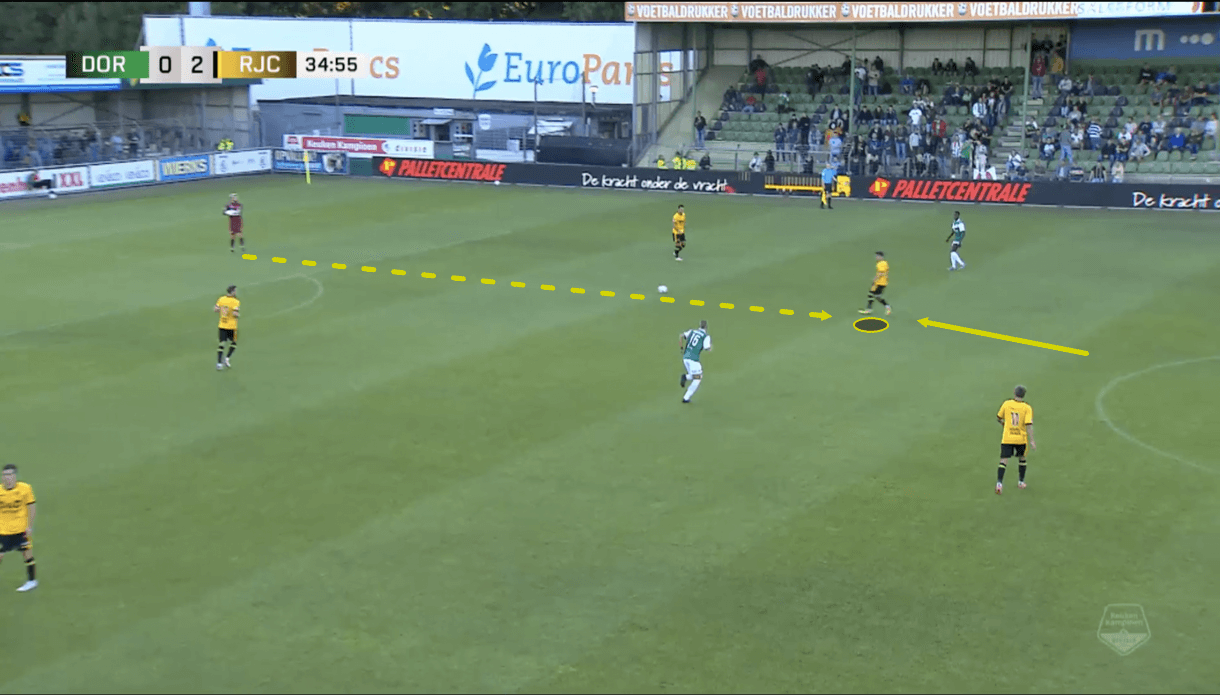
In figures 10-11, we see that the 20-year-old has dropped deep while his side’s centre-backs split apart, enabling him to receive directly from his goalkeeper. As the ball makes its way to him, we see the midfielder check his shoulders several times to ensure he’s not under too much pressure and to create a picture of the pitch ahead of him in his mind. This helps with his decision-making on receiving the ball, right from his very first touch.
We can see that the midfielder began attracting some pressure as the ball arrived to feet in figure 10. However, this didn’t faze Bouchouari; he remained calm and took the ball on the half-turn, inviting the pressure onto him before choosing just the right moment to explode past the defenders and break into the middle third of the pitch.
This is common in Bouchouari’s game; he is typically confident and composed in possession and backs himself under intense pressure from the opposition.
Sometimes, the midfielder backs himself a little bit too much, leading to him taking a little much out of the ball with his attempted carry — this can lead to turnovers in dangerous positions that leave his team exposed and vulnerable to the impending opposition counter-attack. However, he’s a risk taker on the ball and with risk always comes the possibility that you lose out on occasion.
With that said, his impressive offensive duel success % percentile rank from figure 1 hopefully highlights that he’s quite a reliable player when it comes to dribbling and carries.
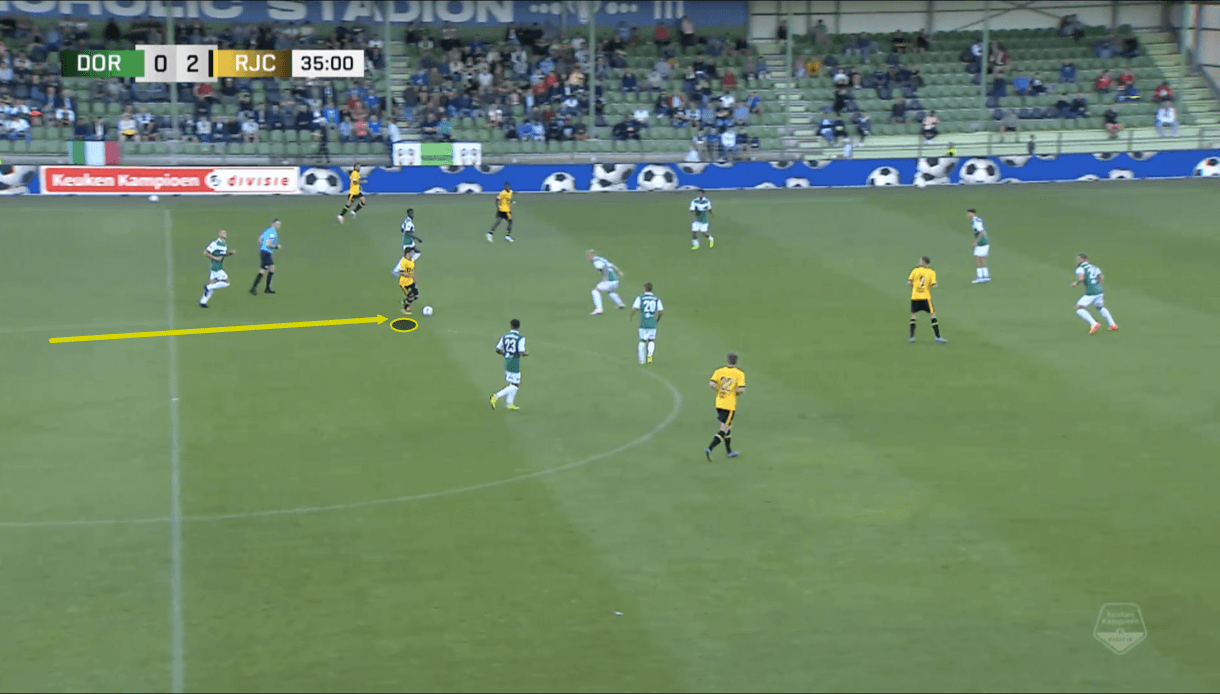
After entering the opposition’s half with this carry, the midfielder has attracted several opposition players towards him, thus creating space elsewhere for his teammates to enjoy and potentially exploit should Bouchouari choose to play the ball to them at the end of this carry.
He’s progressed to a position that gives him plenty of good options at the end of this carry — now, he must just choose one and as this passage of play moves on, we see him take up the option of playing the ball into the centre-forward’s feet while continuing his movement off the ball to offer that player another option, similar to the play we analysed in figure 7.
This opportunity was created by Bouchouari’s confidence, technical dribbling ability and physical traits like agility, balance and a good burst of acceleration on the ball. These are all traits we’d expect to see him carry on using regularly at ASSE, with ball carrying and progressive passing likely to continue playing a key part in whatever role Batlles decides is right for him.
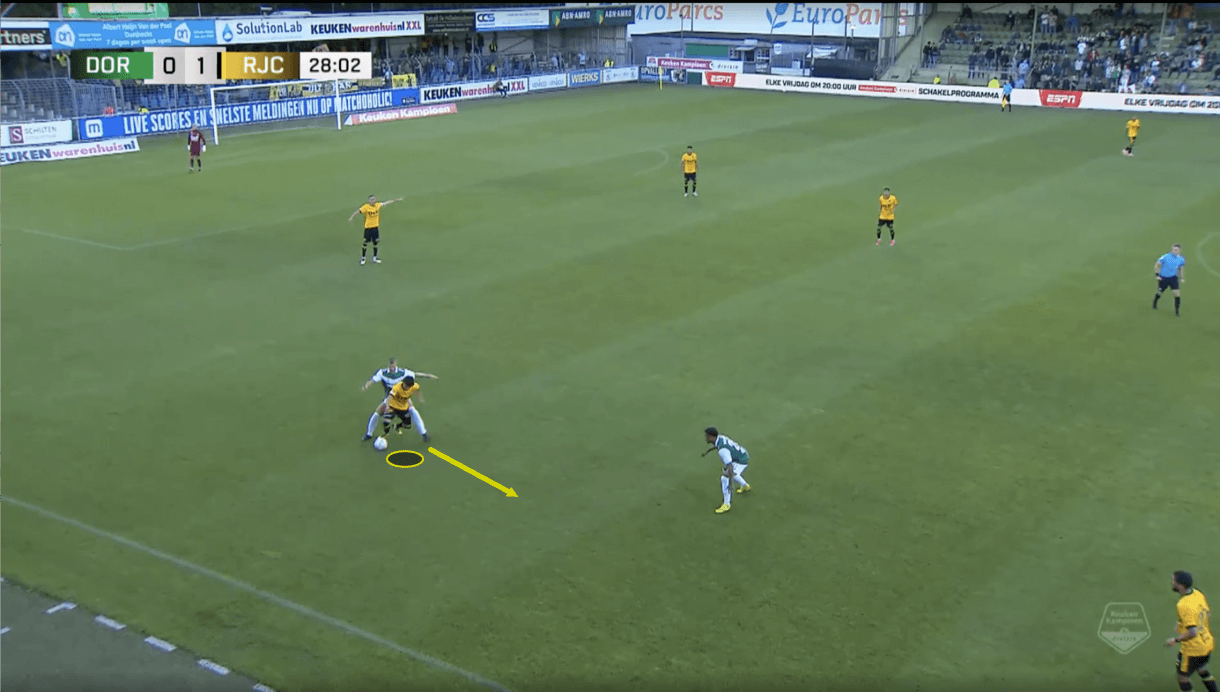
While he stands at just 165cm, Bouchouari is not afraid of using his body to protect the ball and uses his low centre of gravity to ride challenges, enabling his continued progression upfield. We see an example of this in figure 12.
Just before this image, the midfielder received from the backline. After quickly turning, he drew attention from the opposition’s pressing forward, who ended up right on his tail in figure 12. The diminutive midfielder did well to ride the challenge and protect the ball from the challenger while continuing his team’s move by carrying forward and taking on the next opposition defender ahead of him.
Again, as you might assume at this point, he ends up playing a one-two with the teammate we can see on the right-wing just ahead of him in figure 12, with Bouchouari managing to cross the halfway line and enter the opposition’s half as the play moves on.
So, it’s clear that the player’s ability to use his body so well and protect the ball while holding off the defender was pivotal in his team’s progression upfield in this instance.
Physically, of course, Bouchouari could be better, and this is an evident weakness in his game. However, the way he uses his body to his advantage in naturally riding challenges, keeping the play moving upfield and bravely protecting the ball from opposition players goes some way to offsetting the negatives associated with such a small midfielder. The positives don’t outweigh the negatives in this instance, but they do go some way to helping achieve that.
Areas of improvement
In addition to his physicality and occasionally inviting too much pressure and taking too much out of the ball with his carrying, we’ve decided to point out another couple of clear areas of improvement within the 20-year-old Saint-Étienne summer signing’s game: goal threat and defensive output.
In terms of goal threat, it’s not really necessary within his game, but he does the necessary requirements of his current role very well and adding goal threat to his game would be a nice bonus. His technical shooting ability is average enough, he’s got the ability to hit the ball low and hard and potentially trouble the opposition.
However, he lacks composure in front of a goal a lot and at times looks lost when faced with a good goalscoring opportunity.
Bouchouari can also improve at making late runs into the box to avail of potential goalscoring opportunities that this can provide. In doing so, his xG may rise, he’ll see goalscoring opportunities come his way more often and hopefully, along with some other training, this can lead to less panic and more composure in front of goal.
In terms of defensive output, it’s clear that Bouchouari can improve his work rate to an extent. Part of his poor defensive output will come down to physicality, but he can still make strides in his ability to read the game, better defensive positioning and tackling technique.
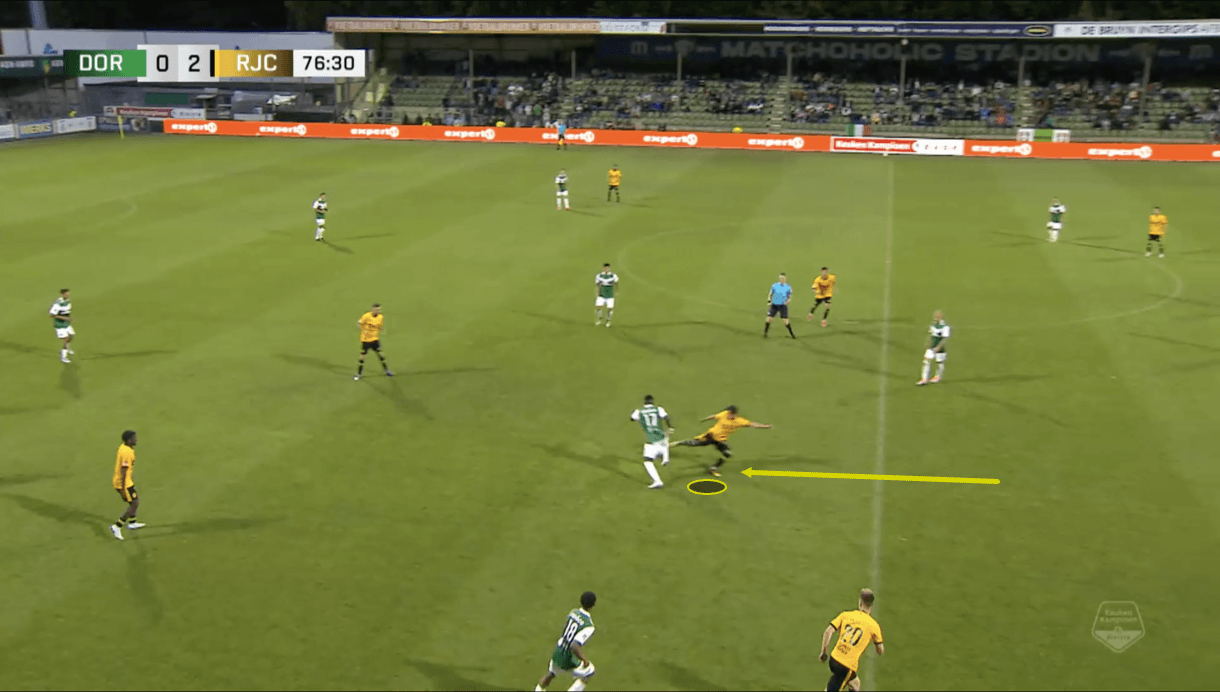
Take figure 13, for example. It’s common to see Bouchouari enter defensive duels like this, swiping a foot across the opposition player but not really doing anything that’s going to stop the opposition’s progress.
He would be better served either defending more passively, focusing on blocking passing lanes and/or marking good passing options or, if he’s going to tackle, doing so when he’s in a better position to do so with his body behind the ball, not swiping a leg across which gives him little chance of coming out on top of the 50/50.
So, little things in terms of positioning and technique could take Bouchouari’s defensive game up a level or two — not necessarily making him a defender at the level of Chelsea starN’Golo Kanté or Real Madrid midfielder Aurélien Tchouaméni but better than he currently is.
Conclusion
To conclude this tactical analysis and scout report, it’s clear that Bouchouari excels on the ball as a progressive midfielder both via his passing and carries. He’s got great technical, physical and mental traits on the ball. Meanwhile, he could improve physically, defensively and in terms of his goal threat.
At present, we feel Bouchouari would be best suited to a double-pivot role in a possession-based system, focusing on shuttling the ball between the thirds, ideally playing next to a more defensive-minded midfielder who’d give him the freedom to roam forward as we’ve seen him do during his time at Roda.
However, we are not Laurent Batlles and we look forward to seeing what the 46-year-old coach has in mind for Bouchouari as he plots Les Verts’ top-flight return.





Comments